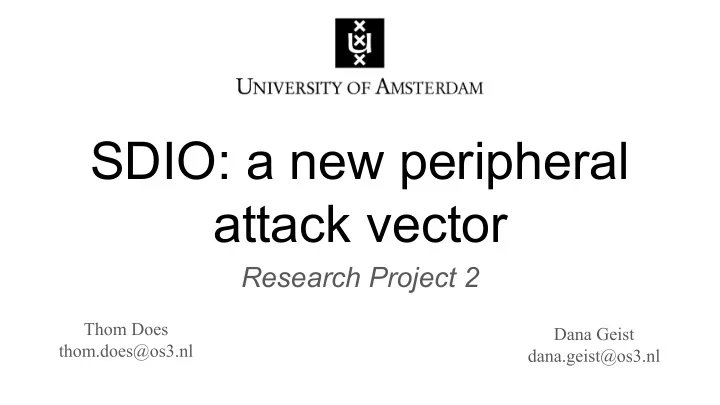

SDIO: a new peripheral attack vector Research Project 2 Thom Does Dana Geist thom.does@os3.nl dana.geist@os3.nl
Introduction ● Secure Digital Input Output (SDIO) ○ Adds I/O functions to SD ○ PDAs, tablets, laptops ● SDIO presents similarities with USB ● BadUSB attack (2014) ○ Inject keystrokes ○ Rogue DHCP ● Seemingly no protections to prevent BadUSB-like attacks 2
Research Question Could SDIO be used as a new attack vector on SDIO-aware hosts? 3
State of art ● No previous research on SDIO as an attack vector ● SD/SDIO specifications ○ Only simplified version available without license ● SD card hack (2013) ○ Several microSD cards were tested ○ Reversed engineered firmware ○ Developed novel applications for microcontroller 4
Attack path: WLAN SDIO card Step 1 5
Attack path: WLAN SDIO card Step 1 6
Attack path: WLAN SDIO card Step 1 7
Attack path: WLAN SDIO card Step 2 8
Attack path: WLAN SDIO card Step 3 9
SDIO Stack 10
Physical Layer: SPI vs. SD SPI SD Wide variety of Used by SD cards and applications readers Well-known “open” License required protocol Simple (one data line) More complex (commands, data lines) Supported natively by Special purpose MCUs or many MCUs bitbanging Fallback protocol for SD Default for SD 11
SDIO Layer ● Maintained by SD association ● Documentation requires licensing ● Defines SDIO commands ○ Formats ○ Initialization ○ Transfer modes ● Master-Slave based protocol ○ The card reader is the Master ○ The SDIO card is the slave 12
Business Logic Layer ● Multiple manufacturers ● Standardized and manufacturer specific interfaces ○ Firmware ○ Drivers ● Each interface is an attack surface ○ WLAN, bluetooth, GPS ● Manipulate higher-level applications ○ DHCP-client, command injection, navigation system 13
SDIO Model 14
SDIO Model: Host’s drivers 15
How can the host system be exploited? 16
How can the host system be exploited? 17
How can the host system be exploited? 18
Build SDIO device from scratch (SPI) If host supports SPI ● Use low cost microcontrollers to implement protocol ● Build low cost sniffers to ease the development ● Use open source software to analyze the protocol ● Not all hosts support SPI 19
Build SDIO device from scratch (SD) If host supports SD only ● Most microcontrollers do not natively support the protocol ● Using commodity hardware for bitbanging could be cumbersome ● No open source protocol analyzers tools ● Complex solutions like FPGA + IP core software ○ Expensive ○ Steep learning curve ○ Requires business logic programming 20
Modify existing firmware ● Get the firmware ● Find hooking points ● Rewrite specific functions ● Two main options: ○ Firmware embedded in SD card ○ Firmware loaded to device by the driver 21
SDIO-based vs. USB-based attacks SDIO attack BadUSB Hosts Laptops, tablets, PDAs Desktops, laptops, printers, routers Devices Limited vendors and applications Many vendors and applications Stealthiness Embedded in port Protruding from port Ease of No “off-the-shelf” products USB Armory, Rubber Ducky, known exploitation vulnerable firmware 22
Discussion ● Licensing required by SD Association ● Attack feasible but: ○ Time consuming ○ Expensive ○ Not possible to create general purpose malicious firmware ● Likelihood ○ Affects SDIO aware hosts only ○ Kernel module needs to be loaded ● Impact: ○ Wide range of attacks possible ● Mitigation: vendors should sign or encrypt their firmware 23
Conclusions ● SDIO cards are supported by various types of hosts ○ Laptops, phones, tablets, PDAs ● SDIO is an attack vector ○ No protections found ● Firmware might be modified, or developed from scratch ○ SD is more effective than SPI ● Currently, SDIO-based attacks seem less likely than USB-based attacks ○ Ease of exploitation ○ Number of vendors / products supporting SDIO ○ Kernel module needs to be loaded 24
References Research material: ● SDIO specifications ○ https://www.sdcard.org/downloads/pls/index.html ● BADUSB - On Accessories that Turn Evil by Karsten Nohl + jakob Lell ○ https://www.youtube.com/watch?v=nuruzFqMgIw ● SD card hack ○ http://hackaday.com/2013/12/29/hacking-sd-card-flash-memory-controllers/ ● A Microcontroller-based HF-RFID Reader Implementation for the SD-Slot ○ http://www.thinkmind.org/download.php?articleid=icds_2011_4_30_10048 Images: ● https://www.parallella.org/create-sdcard/ ● http://www.techrific.com.au/2005/06/wifi-sd-card-spectec-in-stock.html ● http://www.actel.com/ipdocs/iW-SDIO_Slave_demo_board_DS.pdf ● https://www.sdcard.org/developers/overview/sdio/index.html 25
Recommend
More recommend